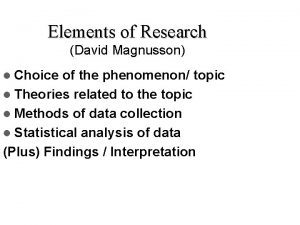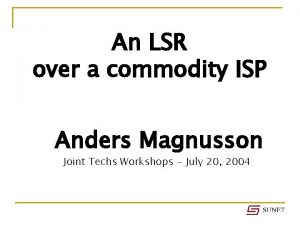Elements of Research David Magnusson l Choice of

























- Slides: 25

Elements of Research (David Magnusson) l Choice of the phenomenon/ topic l Theories related to the topic l Methods of data collection l Statistical analysis of data (Plus) Findings / Interpretation

Interpersonal Needs of Managers & Management Students: An Exploratory Study Conducted in India by M. J. Arul.

Relevance of the Study Choice of the phenomenon Theories related to the topic Methods of data collection Statistical analysis of data Findings / Interpretation l IPR: integral part of managerial job (Eg: Mintzberg-’ 75, Kotter-’ 82, Stewart-’ 82. ) l IPR influences organisational performance (Eg: “Hawthorne”, Weick-’ 69, Zalenzik-’ 77, Liden & Graen-’ 80, Bohra & Pandey’ 84, Wayne & Ferris-’ 90, Pestonjee-’ 92) l IPR is a function of IPB l Dearth of studies on IPB l Hence study of IPB.

The Purpose l To Choice of the phenomenon Theories related to the topic Methods of data collection Statistical analysis of data Findings / Interpretation build up an empirical base for understanding IPB of managers. l To map the IP orientations of managers. l To facilitate intervention for managerial effectiveness. l To help evolve informed MBA curriculum.

Choice of the phenomenon Theories related to the topic Theories / Frameworks l Review Methods of data collection Statistical analysis of data Findings / Interpretation of literature: – Motivational theories – Personality theories – Theories of IPB (Berne’s TA, Freedman. Leary model, Benjamin’s SASB, Schutz’ FIRO, Gilbert’s Evolutionism. ) l Choice: The revised FIRO

Choice of the phenomenon Theories related to the topic Methods of data collection Methodology l The sample l The Variables l Measurement l Tools of analysis Statistical analysis of data Findings / Interpretation

Choice of the phenomenon Theories related to the topic Methods of data collection The Sample Statistical analysis of data Findings / Interpretation 1. Coverage 2. Gender & regional composition 3. Age groups 4. Academic background 5. Work department

Choice of the phenomenon Theories related to the topic Methods of data collection 1: Coverage l Number Statistical analysis of data Findings / Interpretation of States: 13 out of 25 l Co-op dairies: 45 out of 170 l Total size of sample: 575

Choice of the phenomenon Theories related to the topic Methods of data collection 2. Gender and Region Statistical analysis of data Findings / Interpretation

Choice of the phenomenon Theories related to the topic Methods of data collection 3. Age Groups Statistical analysis of data Findings / Interpretation

4. Academic Background Choice of the phenomenon Theories related to the topic Methods of data collection Statistical analysis of data Findings / Interpretation

5. Work Departments Choice of the phenomenon Theories related to the topic Methods of data collection Statistical analysis of data Findings / Interpretation

Main-line Variables Choice of the phenomenon Theories related to the topic Methods of data collection Statistical analysis of data Findings / Interpretation Variable Name Label Scale Name Perceived-Expressed Inclusion Perceived-Expressed Control Perceived-Expressed Openness Wanted-Expressed Inclusion Wanted-Expressed Control Wanted-Expressed Openness Perceived-Received Inclusion Perceived-Received Control Perceived-Received Openness Wanted-Received Inclusion Wanted-Received Control Wanted-Received Openness PEI PEC PEO WEI WEC WEO PRI PRC PRO WRI WRC WRO I include people I control people I am open with people I want to include people I want to control people I want to be open with people People include me People control me People are open with me I want people to include me I want people to control me I want people to be open with me

Choice of the phenomenon Theories related to the topic Methods of data collection Side-line Variables l Group performance l Compatibility l Success l Satisfaction Statistical analysis of data Findings / Interpretation

Choice of the phenomenon Theories related to the topic Methods of data collection Measurement of Variables Statistical analysis of data Findings / Interpretation l The IPB dimensions by Element-B l Compatibility by {abs(E-WR)} (smaller difference = greater compatibility. ) l Group performance by evaluation of grp assignments

Choice of the phenomenon Theories related to the topic Methods of data collection Measurement Contd. l Successful Statistical analysis of data Findings / Interpretation vs Not-so-successful – Managers: as judged by no less than 80% of peers and superiors. – Students: By their OGPA. l Satisfaction by a single-item subjective response

Statistical Treatment l Descriptive Choice of the phenomenon Theories related to the topic Methods of data collection Statistical analysis of data Findings / Interpretation analysis – Relative Frequency, Means & SDs – T-test l Inferential analysis – Pearson’s correlation coefficient – ANOVA – Multiple Discriminant Analysis

Results (See hand-outs) l Tables: Choice of the phenomenon Theories related to the topic Methods of data collection Statistical analysis of data Findings / Interpretation 4. 1, 4. 4. 2, 4. 5. 7, 4. 5. 8. l Figs: M 1, M 2, M 3, S 1, S 2, S 3; 4. 1. 13; 4. 3. 1, 4. 3. 2. [Press Esc; resume after reading handouts. ]

Major Findings l l l Choice of the phenomenon Theories related to the topic Methods of data collection Statistical analysis of data Findings / Interpretation One’s FIRO is not related to one’s Academic Ba Managers’ age correlates (+) with their PEI, PEC Students’ WRC is related (+) to their Age. Managers’ PRC correlates with their WRC (+) an Students’ PRC: the same; plus with PEC and P

Findings Contd. l Regional Choice of the phenomenon Theories related to the topic Methods of data collection Statistical analysis of data Findings / Interpretation diffs found in FIROs of managers; not of students. l “Good” & “bad” managers differ on PEC, WEC, PRC, WEO and WRO. l Student success not related to their FIRO. l Girls & Boys differed on WEI(-), PRO (+), WRC(-) and WRO(+).

Findings Contd. l Compatibility Choice of the phenomenon Theories related to the topic Methods of data collection Statistical analysis of data Findings / Interpretation increases satisfaction (+r p<0. 01; t-ratio p<0. 05). l Performance not related to overall FIRO compatibility. l Compatibility in Openness was +vely related to performance (p<0. 05).

Findings Contd. Choice of the phenomenon Theories related to the topic Methods of data collection Statistical analysis of data Findings / Interpretation According to Mc. Clelland’s research, effective managers score high on n. Power and low on n. Aff. The findings of the present study confirm it (if n. Power is equated with Control and n. Aff with Inclusion).

M. J. Arul

Open for Discussion Choice of the phenomenon Theories related to the topic Methods of data collection Statistical analysis of data Findings / Interpretation QUESTIONS I shall indeed appreciate your questions, insights and comments. -Arul. Please email: arul@myself. com

Arul
 Karin magnusson
Karin magnusson Kristianstad flygklubb
Kristianstad flygklubb Joachim magnusson mariestad
Joachim magnusson mariestad Dani bailey
Dani bailey Hypothyroidea
Hypothyroidea Michelle magnusson
Michelle magnusson Good choice or bad choice
Good choice or bad choice Jingles are musical messages written around the brand
Jingles are musical messages written around the brand Elements of a play
Elements of a play Overhead allocation
Overhead allocation Atomic elements vs molecular elements
Atomic elements vs molecular elements Http //elements.wlonk.com/elements table.htm
Http //elements.wlonk.com/elements table.htm What are the features of folktales
What are the features of folktales Name the elements of a folktale
Name the elements of a folktale Introduction of research proposal
Introduction of research proposal Non contrived setting
Non contrived setting Nuremberg code
Nuremberg code Categoring
Categoring How to write research methodology chapter 3
How to write research methodology chapter 3 Noncontrived
Noncontrived Research report vs research proposal
Research report vs research proposal Research methodology
Research methodology Appendix in research paper
Appendix in research paper Conclusive research design includes
Conclusive research design includes Applied vs fundamental research
Applied vs fundamental research Explain types of research
Explain types of research












































